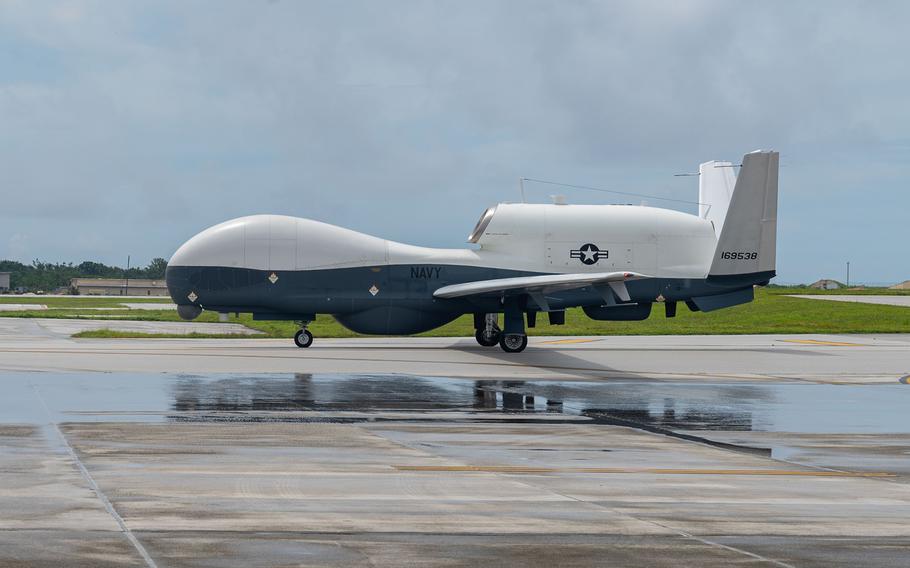Asia-Pacific
Okinawa left with no shortage of surveillance drones following Tritons’ departure
Stars and Stripes November 1, 2024

Since 2017, Northrop Grumman has received more than $600 million in Navy contracts to produce and modify the MQ-4C Tritons. (U.S. Air Force)
A pair of Navy surveillance drones have returned to Andersen Air Force Base on Guam after working out of Okinawa for five months, according to the sea service.
Even with the MQ-4C Tritons’ departure, drones will continue to fly from Kadena Air Base courtesy of ongoing Air Force and Marine Corps deployments.
The Tritons, which arrived at the 18th Wing’s home in May, carried out intelligence, surveillance and reconnaissance operations on behalf of Indo-Pacific Command and were not a response to any specific provocation or action, according to a 7th Fleet spokeswoman.
“We will continue to closely coordinate with the Government of Japan and leadership in Guam on the MQ-4C deployment,” she told Stars and Stripes via email Thursday.
The Triton resembles the RQ-4 Global Hawk, but its wings are stiffened to permit dives to below 10,000 feet for a closer look at targets, and the leading edges are toughened to withstand bird strikes. Its avionics are designed to withstand power surges from lightning.
Since 2017, Northrop Grumman has received more than $600 million in Navy contracts to produce and modify the Triton. Each one costs $32.8 million per year to operate.
Merrill would not say when the maritime surveillance aircraft returned to Guam, citing operational security concerns.
However, a spokesman for the Okinawa Defense Bureau, an arm of Japan’s Ministry of Defense, said they left Okinawa in mid-October.
“The bureau shared this information with Okinawa city, Kadena town, Chatan town and the prefecture on Oct. 23,” the spokesman said by phone Thursday. “We cannot answer the specific date they departed because it is related to U.S. military operations.”
A spokeswoman for the prefecture’s Military Base Affairs Division confirmed the notification by phone Thursday but said the prefecture knows no further details.
Some Japanese government officials are required to speak to the media only on condition of anonymity.
The drones were deployed to “conduct intelligence missions in the Nansei region and its surrounding areas, strengthening surveillance and reconnaissance,” the Military Affairs Division spokeswoman said in May. The Nansei, or Ryukyu, islands stretch from Taiwan to Kyushu, the southernmost of Japan’s main islands.
The Marine Corps deployed several MQ-9A Reaper drones to Kadena in August, 1st Marine Aircraft Wing spokeswoman 1st Lt. Jude Hydrick said at the time. The drones are assigned to Marine Unmanned Aerial Vehicle Squadron 3 at Marine Corps Base Hawaii.
The Reaper, made by General Atomics of San Diego, is a medium-altitude, long-endurance aircraft used primarily for surveillance, according to the Air Force. It may also carry Hellfire missiles and Paveway laser-guided bombs and cost $56.5 million each.
Fewer than six Marine Reapers are at Kadena, the defense bureau said at the time. They support “realistic domain awareness training,” 1st Marine Aircraft Wing spokesman Maj. Joseph Butterfield said via email Thursday.
“Selecting Kadena Air Base as the deployment site minimized the impact on our host nation by leveraging existing infrastructure already in use for similar aircraft at the base,” he wrote.
Air Force MQ-9 Reaper drones assigned to the 319th Expeditionary Reconnaissance Squadron also operate from Kadena, 18th Wing spokeswoman Maj. Alli Stormer said by email Thursday.
Eight Air Force Reapers moved to Kadena late last year from Kanoya Air Base on Kyushu.
“The aircraft is conducting airborne reconnaissance operations in close coordination with the Japan Ministry of Defense in furtherance of the U.S.-Japan Treaty of Mutual Cooperation and Security,” she wrote. “Due to operational security, we will not disclose the number of MQ-9s nor any mission specifics.”